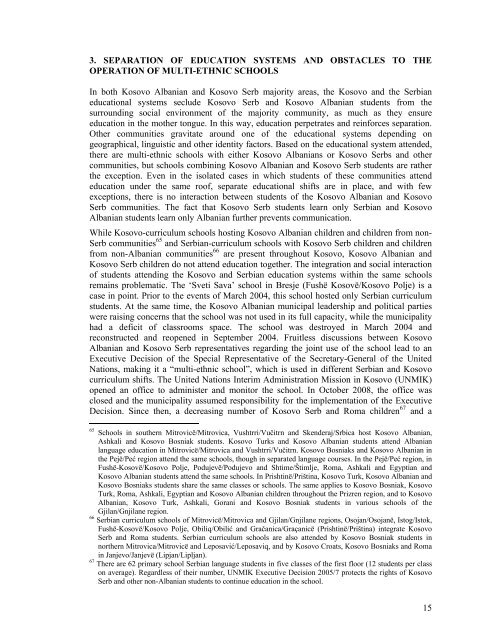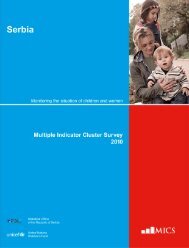Kosovo non-majority communities within the primary and ... - OSCE
Kosovo non-majority communities within the primary and ... - OSCE
Kosovo non-majority communities within the primary and ... - OSCE
Create successful ePaper yourself
Turn your PDF publications into a flip-book with our unique Google optimized e-Paper software.
3. SEPARATION OF EDUCATION SYSTEMS AND OBSTACLES TO THEOPERATION OF MULTI-ETHNIC SCHOOLSIn both <strong>Kosovo</strong> Albanian <strong>and</strong> <strong>Kosovo</strong> Serb <strong>majority</strong> areas, <strong>the</strong> <strong>Kosovo</strong> <strong>and</strong> <strong>the</strong> Serbianeducational systems seclude <strong>Kosovo</strong> Serb <strong>and</strong> <strong>Kosovo</strong> Albanian students from <strong>the</strong>surrounding social environment of <strong>the</strong> <strong>majority</strong> community, as much as <strong>the</strong>y ensureeducation in <strong>the</strong> mo<strong>the</strong>r tongue. In this way, education perpetrates <strong>and</strong> reinforces separation.O<strong>the</strong>r <strong>communities</strong> gravitate around one of <strong>the</strong> educational systems depending ongeographical, linguistic <strong>and</strong> o<strong>the</strong>r identity factors. Based on <strong>the</strong> educational system attended,<strong>the</strong>re are multi-ethnic schools with ei<strong>the</strong>r <strong>Kosovo</strong> Albanians or <strong>Kosovo</strong> Serbs <strong>and</strong> o<strong>the</strong>r<strong>communities</strong>, but schools combining <strong>Kosovo</strong> Albanian <strong>and</strong> <strong>Kosovo</strong> Serb students are ra<strong>the</strong>r<strong>the</strong> exception. Even in <strong>the</strong> isolated cases in which students of <strong>the</strong>se <strong>communities</strong> attendeducation under <strong>the</strong> same roof, separate educational shifts are in place, <strong>and</strong> with fewexceptions, <strong>the</strong>re is no interaction between students of <strong>the</strong> <strong>Kosovo</strong> Albanian <strong>and</strong> <strong>Kosovo</strong>Serb <strong>communities</strong>. The fact that <strong>Kosovo</strong> Serb students learn only Serbian <strong>and</strong> <strong>Kosovo</strong>Albanian students learn only Albanian fur<strong>the</strong>r prevents communication.While <strong>Kosovo</strong>-curriculum schools hosting <strong>Kosovo</strong> Albanian children <strong>and</strong> children from <strong>non</strong>-Serb <strong>communities</strong> 65 <strong>and</strong> Serbian-curriculum schools with <strong>Kosovo</strong> Serb children <strong>and</strong> childrenfrom <strong>non</strong>-Albanian <strong>communities</strong> 66 are present throughout <strong>Kosovo</strong>, <strong>Kosovo</strong> Albanian <strong>and</strong><strong>Kosovo</strong> Serb children do not attend education toge<strong>the</strong>r. The integration <strong>and</strong> social interactionof students attending <strong>the</strong> <strong>Kosovo</strong> <strong>and</strong> Serbian education systems <strong>within</strong> <strong>the</strong> same schoolsremains problematic. The ‘Sveti Sava’ school in Bresje (Fushë Kosovë/<strong>Kosovo</strong> Polje) is acase in point. Prior to <strong>the</strong> events of March 2004, this school hosted only Serbian curriculumstudents. At <strong>the</strong> same time, <strong>the</strong> <strong>Kosovo</strong> Albanian municipal leadership <strong>and</strong> political partieswere raising concerns that <strong>the</strong> school was not used in its full capacity, while <strong>the</strong> municipalityhad a deficit of classrooms space. The school was destroyed in March 2004 <strong>and</strong>reconstructed <strong>and</strong> reopened in September 2004. Fruitless discussions between <strong>Kosovo</strong>Albanian <strong>and</strong> <strong>Kosovo</strong> Serb representatives regarding <strong>the</strong> joint use of <strong>the</strong> school lead to anExecutive Decision of <strong>the</strong> Special Representative of <strong>the</strong> Secretary-General of <strong>the</strong> UnitedNations, making it a “multi-ethnic school”, which is used in different Serbian <strong>and</strong> <strong>Kosovo</strong>curriculum shifts. The United Nations Interim Administration Mission in <strong>Kosovo</strong> (UNMIK)opened an office to administer <strong>and</strong> monitor <strong>the</strong> school. In October 2008, <strong>the</strong> office wasclosed <strong>and</strong> <strong>the</strong> municipality assumed responsibility for <strong>the</strong> implementation of <strong>the</strong> ExecutiveDecision. Since <strong>the</strong>n, a decreasing number of <strong>Kosovo</strong> Serb <strong>and</strong> Roma children 67 <strong>and</strong> a65 Schools in sou<strong>the</strong>rn Mitrovicë/Mitrovica, Vushtrri/Vučitrn <strong>and</strong> Skenderaj/Srbica host <strong>Kosovo</strong> Albanian,Ashkali <strong>and</strong> <strong>Kosovo</strong> Bosniak students. <strong>Kosovo</strong> Turks <strong>and</strong> <strong>Kosovo</strong> Albanian students attend Albanianlanguage education in Mitrovicë/Mitrovica <strong>and</strong> Vushtrri/Vučitrn. <strong>Kosovo</strong> Bosniaks <strong>and</strong> <strong>Kosovo</strong> Albanian in<strong>the</strong> Pejë/Peć region attend <strong>the</strong> same schools, though in separated language courses. In <strong>the</strong> Pejë/Peć region, inFushë-Kosovë/<strong>Kosovo</strong> Polje, Podujevë/Podujevo <strong>and</strong> Shtime/Štimlje, Roma, Ashkali <strong>and</strong> Egyptian <strong>and</strong><strong>Kosovo</strong> Albanian students attend <strong>the</strong> same schools. In Prishtinë/Priština, <strong>Kosovo</strong> Turk, <strong>Kosovo</strong> Albanian <strong>and</strong><strong>Kosovo</strong> Bosniaks students share <strong>the</strong> same classes or schools. The same applies to <strong>Kosovo</strong> Bosniak, <strong>Kosovo</strong>Turk, Roma, Ashkali, Egyptian <strong>and</strong> <strong>Kosovo</strong> Albanian children throughout <strong>the</strong> Prizren region, <strong>and</strong> to <strong>Kosovo</strong>Albanian, <strong>Kosovo</strong> Turk, Ashkali, Gorani <strong>and</strong> <strong>Kosovo</strong> Bosniak students in various schools of <strong>the</strong>Gjilan/Gnjilane region.66 Serbian curriculum schools of Mitrovicë/Mitrovica <strong>and</strong> Gjilan/Gnjilane regions, Osojan/Osojanë, Istog/Istok,Fushë-Kosovë/<strong>Kosovo</strong> Polje, Obiliq/Obilić <strong>and</strong> Gračanica/Graçanicë (Prishtinë/Priština) integrate <strong>Kosovo</strong>Serb <strong>and</strong> Roma students. Serbian curriculum schools are also attended by <strong>Kosovo</strong> Bosniak students innor<strong>the</strong>rn Mitrovica/Mitrovicë <strong>and</strong> Leposavić/Leposaviq, <strong>and</strong> by <strong>Kosovo</strong> Croats, <strong>Kosovo</strong> Bosniaks <strong>and</strong> Romain Janjevo/Janjevë (Lipjan/Lipljan).67 There are 62 <strong>primary</strong> school Serbian language students in five classes of <strong>the</strong> first floor (12 students per classon average). Regardless of <strong>the</strong>ir number, UNMIK Executive Decision 2005/7 protects <strong>the</strong> rights of <strong>Kosovo</strong>Serb <strong>and</strong> o<strong>the</strong>r <strong>non</strong>-Albanian students to continue education in <strong>the</strong> school.15
















